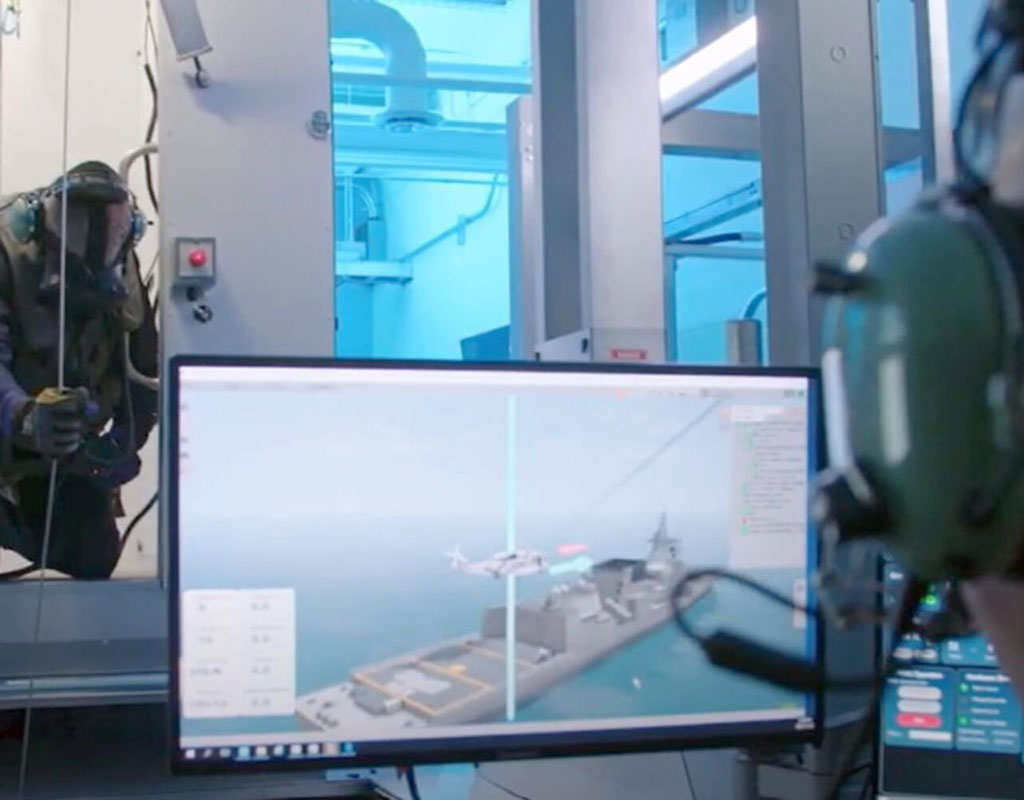
Defense training and simulation company Bluedrop USA is expanding its service offering with the opening of a new Schoolhouse in Orlando, Florida, designed to train hoist operators on initial, recurrent and mission critical operations in a simulated environment.
“Typically, rear crew helicopter operators learn in the classroom and then in the helicopter during on-the-job training,” Brett Ulander, president of Bluedrop USA, told Vertical Valor.“To be able to use the crawl, walk, run approach to training, we get that middle step in the simulator to refine all those skills prior to getting in the aircraft. This is a huge benefit for the crews — obviously for performance and safety.”
The company celebrated the formal inauguration of its Simulation as a Service (SimAAS) Schoolhouse on April 11 during an open house to showcase the company’s full-size rear crew simulator that Bluedrop calls the Hoist Mission Training System (HMTS).
As a subsidiary of Bluedrop Training and Simulation Inc., a Canadian defense and security training company, Bluedrop USA has been providing modeling, simulation, and training solutions for the helicopter defense and security sector since 2020.
One of its biggest customers includes the U.S. Air Force, which purchased a HH-60W Combat Rescue Helicopter Trainer that’s in service at the Kirtland Air Force Base in New Mexico. The team also built for Boeing and the Air Force a CV-22 Special Mission Aviator Ramp Trainer, currently in service at Fort Walton Beach in Florida for the Air Force Special Operations Command (AFSOC) to evaluate. The trainer will later be moved to Kirtland.
“We are in discussions right now with the U.S. Coast Guard, and we’re also working with several civilian companies where we’ve already turned in bids,” Ulander said.
Over the last three years, the U.S. company discovered that the price of quality simulation training was cost prohibitive for many smaller companies. To address this issue, Bluedrop has been piloting its SimAAS offering, allowing a number of organizations to lease time on the company’s trainers.
Trainees from the U.S. Coast Guards, 160th Special Operations Aviation Regiment, Seminole County Sheriff’s Department, and Air Center Helicopters have used the service to train in Bluedrop’s high-fidelity simulation environment.
“The thing that sets us apart from everybody is the fidelity of our simulator — the fact that, in addition to the VR environment, the hoist cable reacts dynamically just like the cable in the aircraft, so rotor wash effects the cable, wind affects the cable, the weight of a survivor affects the cable,” he said.
To improve cable management and muscle memory, trainees practice numerous search-and-rescue missions in various simulated environments, including heavy rain, dense fog, and high winds.
“From a safety perspective, we don’t train in high-risk environments, but you can train high-risk procedures in a very safe environment in the simulator so that when you get out in the real world, it’s not the first time you’re experiencing something like that,” Ulander said.
Ulander said the SIMAAS program “turned out to be a great way to support organizations that didn’t have large training centers. We came to the conclusion that opening our own Schoolhouse would be an advantage and would draw more customers.”
The company said its Schoolhouse is fully equipped for classroom lessons, instructor training, and hoist simulation training in a mixed-reality environment. The facility will be capable of training up to 200 rear crew trainees a year, with the ideal session consisting of four trainees a day.
Bluedrop offers a full curriculum that can be customized based on the customers’ needs and existing curriculum, and classes can either be taught by one of Bluedrop’s two instructors, or customers can bring in their own instructor.
“We also offer a ‘train the trainer’ program to train their instructors to utilize the sim without our personnel, if they want to,” Ulander said. “But most organizations prefer to have our instructors run the simulator, and then bring in an instructor and have their trainees train on it.”
And in order to improve pilot and rear crew communication and coordination, Bluedrop plans to add a single-seat pilot trainer that links to the rear crew trainer.
“That will allow the helicopter crew to train together in the simulator instead of just training the crew members in the back and then have them meet the pilot out in the helicopter,” Ulander said. “They can operate as a crew with the two simulators linked together, and then go out and do the same thing in the air.”

